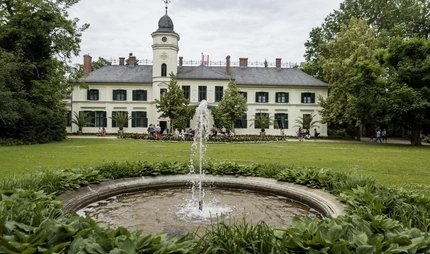
Späth-Arboretum
For research and recreation
Currently closed
Please note: The current opening and closing hours and special hygiene rules for the Covid-19 are available on this website.
There are around 1,200 trees and more than 4,000 plant species to be found in the Späth-Arboretum, which is designed in the style of a English landscape garden. Botanist Franz Späth called this garden home during the 19th century. At that time, as well as today, the park is a recreational space consisting of stately old trees, elaborate and attractive stone architecture and a large pond. However, the park is also used for research: since 1961 the arboretum has belonged to the Institute of Biology at Humboldt University.
A green oasis in the heart of the city
Franz Späth is a gardener, botanist and tree nursery owner during the 19th century, and thus it is not surprising that the design of his garden is important to him. He creates the arboretum in 1879 and uses it to display his tree nursery. The architect is garden director Johann Heinrich Gustav Meyer, and the arboretum becomes a park in the style of English landscape gardens. Over the years, many prominent visitors plant trees here, including Reichskanzler Otto Fürst von Bismarck who picks up the spade in 1884. Since 1961, when Humboldt University takes over, research and teaching becomes an important aspect of the facility. In 1966 the park is opened to the public. Today the Späth-Arboretum covers a total area of 3.5 hectares and is divided into 32 sections. Directly at the entrance is Späth’s stately home covered with climbing ivy. From here, visitors walk along winding paths to the large pond where reeds and sedges grow, providing a beautiful photography opportunity. The oldest tree in the park is a Whitebeam, dating back to 1880. Dotted among the trees, you will discover sculptures including Robert Metzke's "Young Girl", and there is an attractive rock garden complete with mountain plants to visit. As you walk around, you can discover more information about plant classification on display boards, as well as beds with medicinal and spice plants. The park also hosts popular concerts at the beginning and end of each season.
The plant world in the Späth-Arboretum
- Over 1,000 tree species.
- Large pond, fed by rain water and wells.
- Whitebeam planted in 1880, the oldest tree in the arboretum.
- Bismarck linden tree (1884).
- A rock garden in beautiful wild surroundings.
- Interesting plants like the "poison plant of the year".
Berlin's botanical gardens
Around 12 km west of the Späth-Arboretum lies Berlin’s botanical garden in Berlin-Lichterfelde. Here are specimens from almost all vegetation zones on Earth including plants from the Alps, Asia and the tropical rainforests. Exotic plants in the Great Tropical House include palm trees, giant bamboo, bromeliads and fig trees. The Botanische Garten is the largest in Germany with some 22,000 species of plants. The Botanische Museum showcases the history of botany and details the internal structure of plants. The Blankenfelde-Pankow Botanical Park is located to the north of Berlin. There are about 6,000 species of plants here, many of which are endangered. The 31-metre-wide Geological Wall consists of more than 100 types of German rock. The park also includes fallow deer and an apiary. Café Mint's team invite you to relax in the old greenhouse.
Tips about the Späth-Arboretum
The Späth Arboretum is open for visitors between spring and autumn and is best reached by S-Bahn (lines 8, 9, 45, 46, 47 and 85) to Baumschulenweg. From here you arrive at Baumschulenstraße directly by the park. Dates for guided tours can be found on the Humboldt University website. Pre-registration is possible by e-mail or telephone.
Opening hours
| Wednesday | |
|---|---|
| Thursday | |
| Saturday | |
| Sunday |



